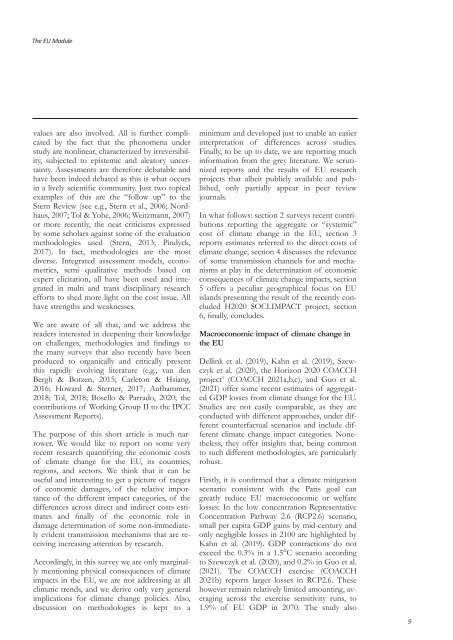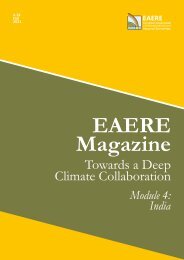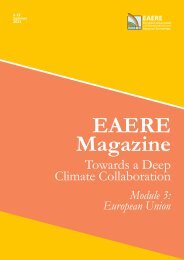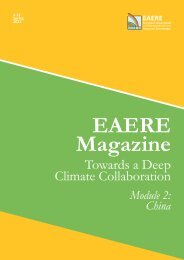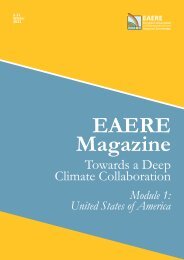EAERE Magazine - N.16 Spring 2022__
Create successful ePaper yourself
Turn your PDF publications into a flip-book with our unique Google optimized e-Paper software.
The EU Module<br />
values are also involved. All is further complicated<br />
by the fact that the phenomena under<br />
study are nonlinear, characterized by irreversibility,<br />
subjected to epistemic and aleatory uncertainty.<br />
Assessments are therefore debatable and<br />
have been indeed debated as this is what occurs<br />
in a lively scientific community. Just two topical<br />
examples of this are the “follow up” to the<br />
Stern Review (see e.g., Stern et al., 2006; Nordhaus,<br />
2007; Tol & Yohe, 2006; Weitzmann, 2007)<br />
or more recently, the neat criticisms expressed<br />
by some scholars against some of the evaluation<br />
methodologies used (Stern, 2013; Pindyck,<br />
2017). In fact, methodologies are the most<br />
diverse. Integrated assessment models, econometrics,<br />
semi qualitative methods based on<br />
expert elicitation, all have been used and integrated<br />
in multi and trans disciplinary research<br />
efforts to shed more light on the cost issue. All<br />
have strengths and weaknesses.<br />
We are aware of all that, and we address the<br />
readers interested in deepening their knowledge<br />
on challenges, methodologies and findings to<br />
the many surveys that also recently have been<br />
produced to organically and critically present<br />
this rapidly evolving literature (e.g., van den<br />
Bergh & Botzen, 2015; Carleton & Hsiang,<br />
2016; Howard & Sterner, 2017; Aufhammer,<br />
2018; Tol, 2018; Bosello & Parrado, 2020; the<br />
contributions of Working Group II to the IPCC<br />
Assessment Reports).<br />
The purpose of this short article is much narrower.<br />
We would like to report on some very<br />
recent research quantifying the economic costs<br />
of climate change for the EU, its countries,<br />
regions, and sectors. We think that it can be<br />
useful and interesting to get a picture of ranges<br />
of economic damages, of the relative importance<br />
of the different impact categories, of the<br />
differences across direct and indirect costs estimates<br />
and finally of the economic role in<br />
damage determination of some non-immediately<br />
evident transmission mechanisms that are receiving<br />
increasing attention by research.<br />
Accordingly, in this survey we are only marginally<br />
mentioning physical consequences of climate<br />
impacts in the EU, we are not addressing at all<br />
climatic trends, and we derive only very general<br />
implications for climate change policies. Also,<br />
discussion on methodologies is kept to a<br />
minimum and developed just to enable an easier<br />
interpretation of differences across studies.<br />
Finally, to be up to date, we are reporting much<br />
information from the grey literature. We scrutinized<br />
reports and the results of EU research<br />
projects that albeit publicly available and published,<br />
only partially appear in peer review<br />
journals.<br />
In what follows: section 2 surveys recent contributions<br />
reporting the aggregate or “systemic”<br />
cost of climate change in the EU, section 3<br />
reports estimates referred to the direct costs of<br />
climate change, section 4 discusses the relevance<br />
of some transmission channels for and mechanisms<br />
at play in the determination of economic<br />
consequences of climate change impacts, section<br />
5 offers a peculiar geographical focus on EU<br />
islands presenting the result of the recently concluded<br />
H2020 SOCLIMPACT project, section<br />
6, finally, concludes.<br />
Macroeconomic impact of climate change in<br />
the EU<br />
Dellink et al. (2019), Kahn et al. (2019), Szewczyk<br />
et al. (2020), the Horizon 2020 COACCH<br />
project 1 (COACCH 2021a,b,c), and Guo et al.<br />
(2021) offer some recent estimates of aggregated<br />
GDP losses from climate change for the EU.<br />
Studies are not easily comparable, as they are<br />
conducted with different approaches, under different<br />
counterfactual scenarios and include different<br />
climate change impact categories. Nonetheless,<br />
they offer insights that, being common<br />
to such different methodologies, are particularly<br />
robust.<br />
Firstly, it is confirmed that a climate mitigation<br />
scenario consistent with the Paris goal can<br />
greatly reduce EU macroeconomic or welfare<br />
losses: In the low concentration Representative<br />
Concentration Pathway 2.6 (RCP2.6) scenario,<br />
small per capita GDP gains by mid-century and<br />
only negligible losses in 2100 are highlighted by<br />
Kahn et al. (2019). GDP contractions do not<br />
exceed the 0.3% in a 1.5°C scenario according<br />
to Szewczyk et al. (2020), and 0.2% in Guo et al.<br />
(2021). The COACCH exercise (COACCH<br />
2021b) reports larger losses in RCP2.6. These<br />
however remain relatively limited amounting, averaging<br />
across the exercise sensitivity runs, to<br />
1.9% of EU GDP in 2070. The study also<br />
9


